Abstract
Human immunodeficiency virus (HIV) infection is a critical problem among the incarcerated population, with rates as high as 17% being reported for prison systems in New York. The literature suggests that stressful living conditions and inherent defects in the immune system associated with HIV infection make prison populations more susceptible to a disproportionate decrease in their CD4 counts. To determine the effects of incarceration on HIV-infected individuals, the charts of 800 inmates were reviewed. Baseline (draw 1), 2- to 5-month (draw 2), and 6- to 12-month (draw 3) CD4 cell counts were obtained. Mean cell counts were calculated, and paired t-tests were used to identify differences. The group receiving antiretrovirals throughout showed no difference in mean CD4 cell count between draws 1 and 2 or between draws 1 and 3. The group not receiving HIV medications did not show a significant difference in CD4 cell counts between draws 1 and 2, but did show a significant difference between draws 1 and 3. For this group, the rate of decline in CD4 cells was greater than among an outpatient setting. The subsample of subjects initiating therapy prior to the second blood draw showed a significant increase in mean CD4 cell counts at draw 1 versus draw 2, but did not show a significant change when comparing draw 1 to draw 3. When examining subjects based on their antiviral status, the mean CD4 cell count at each of the draws was statistically associated with subjects' antiviral status. We conclude that incarceration causes a more rapid decrease in CD4 cells compared with an outpatient population, causing clinical significance on the normal course of HIV disease.
Full text
PDF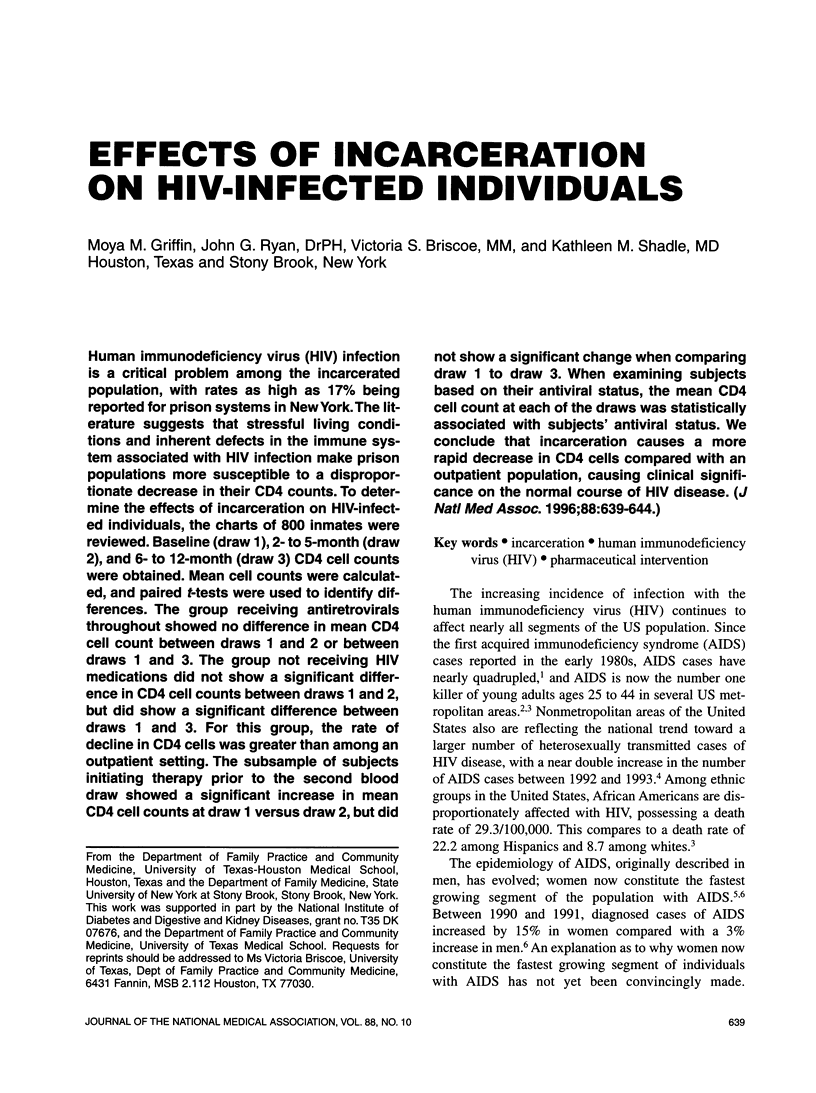
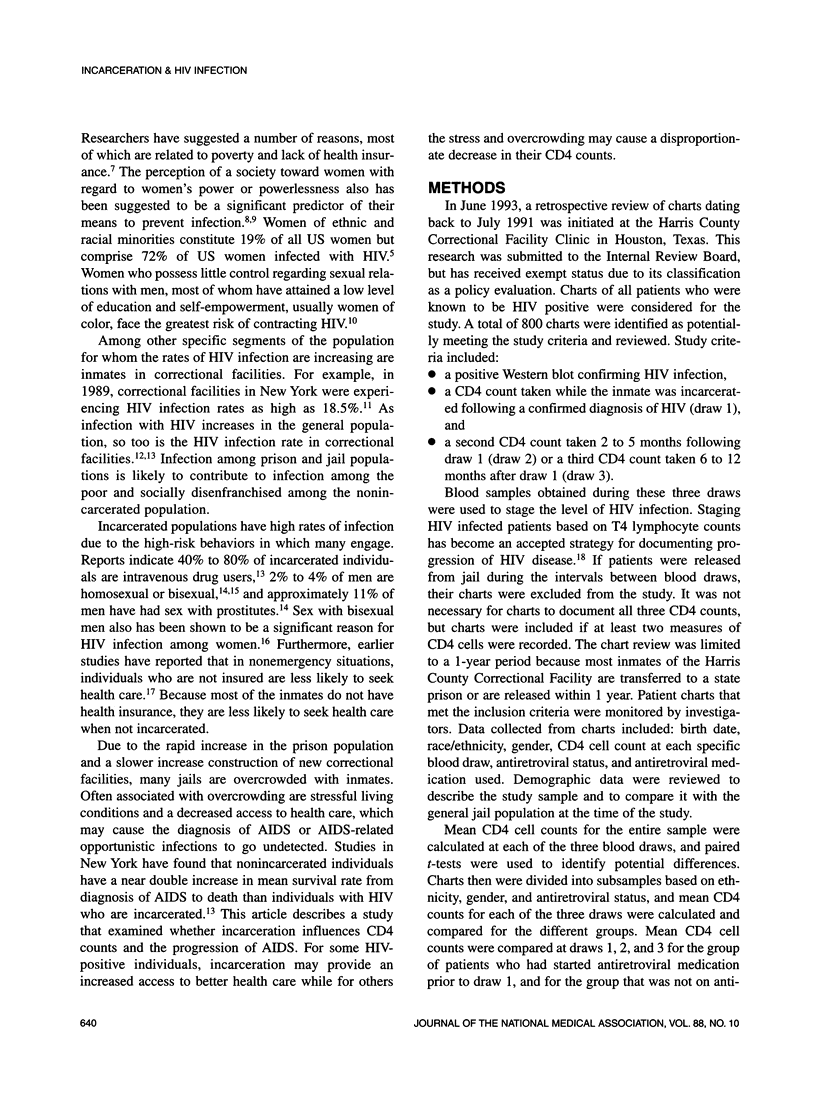
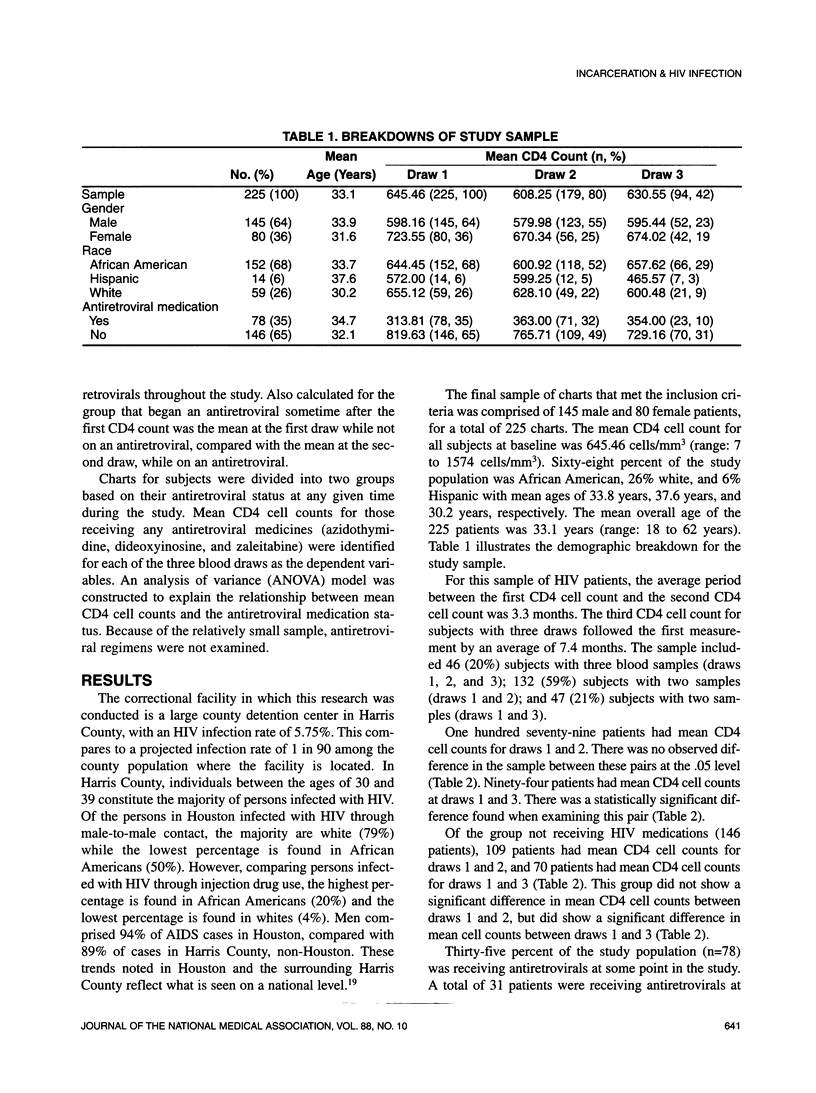
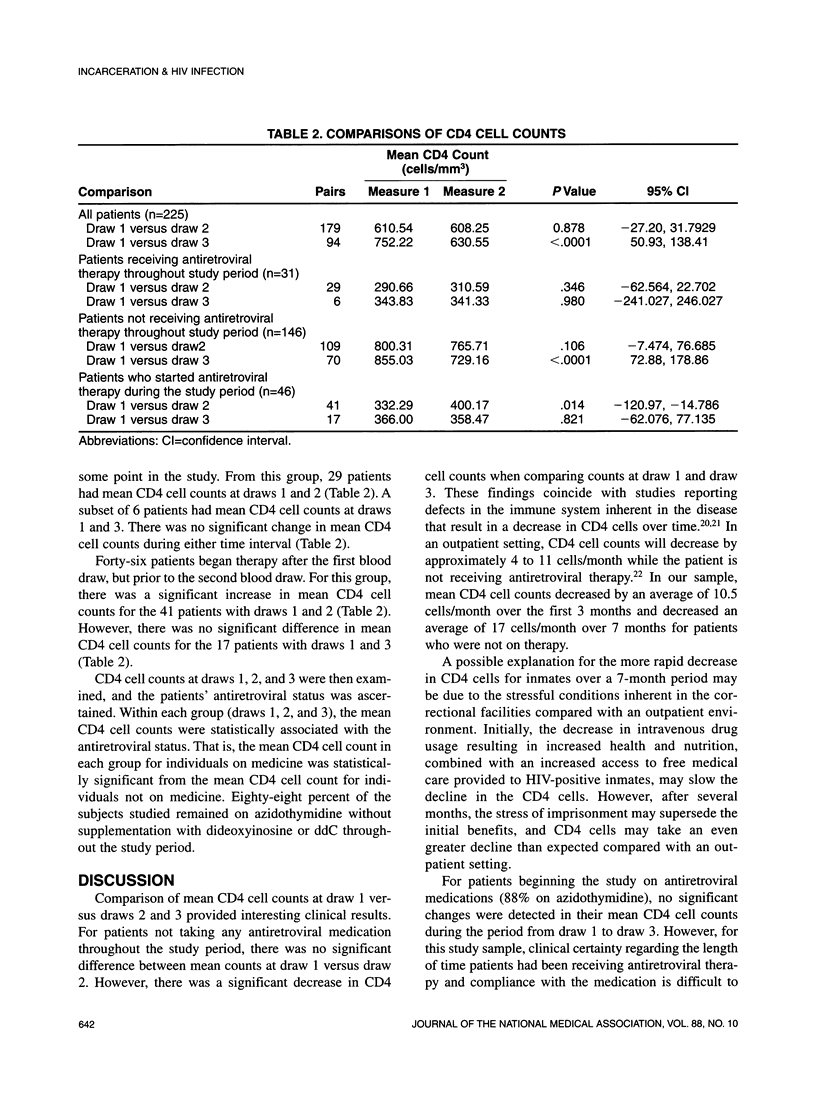
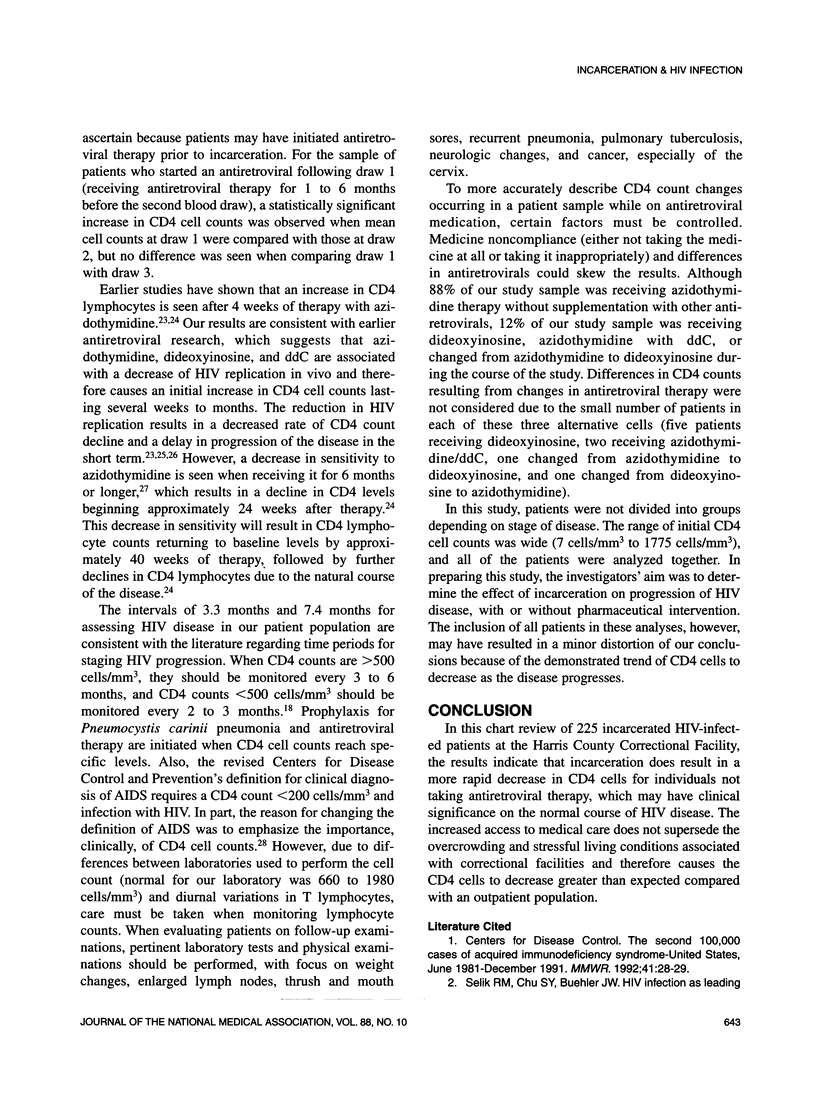
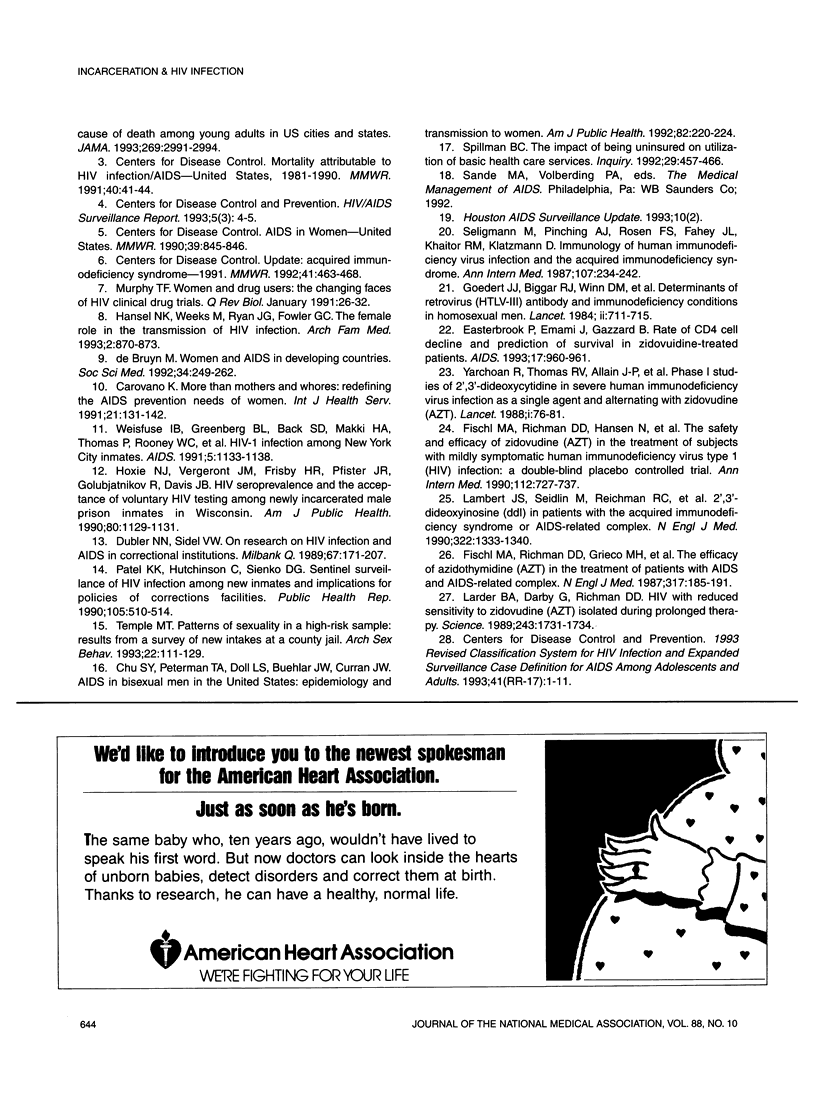
Selected References
These references are in PubMed. This may not be the complete list of references from this article.
- Carovano K. More than mothers and whores: redefining the AIDS prevention needs of women. Int J Health Serv. 1991;21(1):131–142. doi: 10.2190/VD7T-371M-5G9P-QNBU. [DOI] [PubMed] [Google Scholar]
- Centers for Disease Control (CDC) AIDS in women--United States. MMWR Morb Mortal Wkly Rep. 1990 Nov 30;39(47):845–846. [PubMed] [Google Scholar]
- Centers for Disease Control (CDC) Mortality attributable to HIV infection/AIDS--United States, 1981-1990. MMWR Morb Mortal Wkly Rep. 1991 Jan 25;40(3):41–44. [PubMed] [Google Scholar]
- Centers for Disease Control (CDC) The second 100,000 cases of acquired immunodeficiency syndrome--United States, June 1981-December 1991. MMWR Morb Mortal Wkly Rep. 1992 Jan 17;41(2):28–29. [PubMed] [Google Scholar]
- Centers for Disease Control (CDC) Update: acquired immunodeficiency syndrome--United States, 1991. MMWR Morb Mortal Wkly Rep. 1992 Jul 3;41(26):463–468. [PubMed] [Google Scholar]
- Chu S. Y., Peterman T. A., Doll L. S., Buehler J. W., Curran J. W. AIDS in bisexual men in the United States: epidemiology and transmission to women. Am J Public Health. 1992 Feb;82(2):220–224. doi: 10.2105/ajph.82.2.220. [DOI] [PMC free article] [PubMed] [Google Scholar]
- Dubler N. N., Sidel V. W. On research on HIV infection and AIDS in correctional institutions. Milbank Q. 1989;67(2):171–207. [PubMed] [Google Scholar]
- Fischl M. A., Richman D. D., Grieco M. H., Gottlieb M. S., Volberding P. A., Laskin O. L., Leedom J. M., Groopman J. E., Mildvan D., Schooley R. T. The efficacy of azidothymidine (AZT) in the treatment of patients with AIDS and AIDS-related complex. A double-blind, placebo-controlled trial. N Engl J Med. 1987 Jul 23;317(4):185–191. doi: 10.1056/NEJM198707233170401. [DOI] [PubMed] [Google Scholar]
- Fischl M. A., Richman D. D., Hansen N., Collier A. C., Carey J. T., Para M. F., Hardy W. D., Dolin R., Powderly W. G., Allan J. D. The safety and efficacy of zidovudine (AZT) in the treatment of subjects with mildly symptomatic human immunodeficiency virus type 1 (HIV) infection. A double-blind, placebo-controlled trial. The AIDS Clinical Trials Group. Ann Intern Med. 1990 May 15;112(10):727–737. doi: 10.7326/0003-4819-112-10-727. [DOI] [PubMed] [Google Scholar]
- Goedert J. J., Sarngadharan M. G., Biggar R. J., Weiss S. H., Winn D. M., Grossman R. J., Greene M. H., Bodner A. J., Mann D. L., Strong D. M. Determinants of retrovirus (HTLV-III) antibody and immunodeficiency conditions in homosexual men. Lancet. 1984 Sep 29;2(8405):711–716. doi: 10.1016/s0140-6736(84)92624-2. [DOI] [PubMed] [Google Scholar]
- Hispanic health and nutrition examination survey, 1982-84: findings on health status and health care needs. Am J Public Health. 1990 Dec;80 (Suppl):1–70. [PubMed] [Google Scholar]
- Kaldor J. M., Day N. E., Pettersson F., Clarke E. A., Pedersen D., Mehnert W., Bell J., Høst H., Prior P., Karjalainen S. Leukemia following chemotherapy for ovarian cancer. N Engl J Med. 1990 Jan 4;322(1):1–6. doi: 10.1056/NEJM199001043220101. [DOI] [PubMed] [Google Scholar]
- Larder B. A., Darby G., Richman D. D. HIV with reduced sensitivity to zidovudine (AZT) isolated during prolonged therapy. Science. 1989 Mar 31;243(4899):1731–1734. doi: 10.1126/science.2467383. [DOI] [PubMed] [Google Scholar]
- Moss H. B., Panzak G. L., Tarter R. E. Sexual functioning of male anabolic steroid abusers. Arch Sex Behav. 1993 Feb;22(1):1–12. doi: 10.1007/BF01552908. [DOI] [PubMed] [Google Scholar]
- Murphy T. F. Women and drug users: the changing faces of HIV clinical drug trials. QRB Qual Rev Bull. 1991 Jan;17(1):26–32. doi: 10.1016/s0097-5990(16)30417-1. [DOI] [PubMed] [Google Scholar]
- Patel K. K., Hutchinson C., Sienko D. G. Sentinel surveillance of HIV infection among new inmates and implications for policies of corrections facilities. Public Health Rep. 1990 Sep-Oct;105(5):510–514. [PMC free article] [PubMed] [Google Scholar]
- Seligmann M., Pinching A. J., Rosen F. S., Fahey J. L., Khaitov R. M., Klatzmann D., Koenig S., Luo N., Ngu J., Riethmüller G. Immunology of human immunodeficiency virus infection and the acquired immunodeficiency syndrome. An update. Ann Intern Med. 1987 Aug;107(2):234–242. doi: 10.7326/0003-4819-107-2-234. [DOI] [PubMed] [Google Scholar]
- Selik R. M., Chu S. Y., Buehler J. W. HIV infection as leading cause of death among young adults in US cities and states. JAMA. 1993 Jun 16;269(23):2991–2994. [PubMed] [Google Scholar]
- Spillman B. C. The impact of being uninsured on utilization of basic health care services. Inquiry. 1992 Winter;29(4):457–466. [PubMed] [Google Scholar]
- Weisfuse I. B., Greenberg B. L., Back S. D., Makki H. A., Thomas P., Rooney W. C., Rautenberg E. L. HIV-1 infection among New York City inmates. AIDS. 1991 Sep;5(9):1133–1138. doi: 10.1097/00002030-199109000-00013. [DOI] [PubMed] [Google Scholar]
- Yarchoan R., Perno C. F., Thomas R. V., Klecker R. W., Allain J. P., Wills R. J., McAtee N., Fischl M. A., Dubinsky R., McNeely M. C. Phase I studies of 2',3'-dideoxycytidine in severe human immunodeficiency virus infection as a single agent and alternating with zidovudine (AZT). Lancet. 1988 Jan 16;1(8577):76–81. doi: 10.1016/s0140-6736(88)90283-8. [DOI] [PubMed] [Google Scholar]
- de Bruyn M. Women and AIDS in developing countries. Soc Sci Med. 1992 Feb;34(3):249–262. doi: 10.1016/0277-9536(92)90267-t. [DOI] [PubMed] [Google Scholar]


